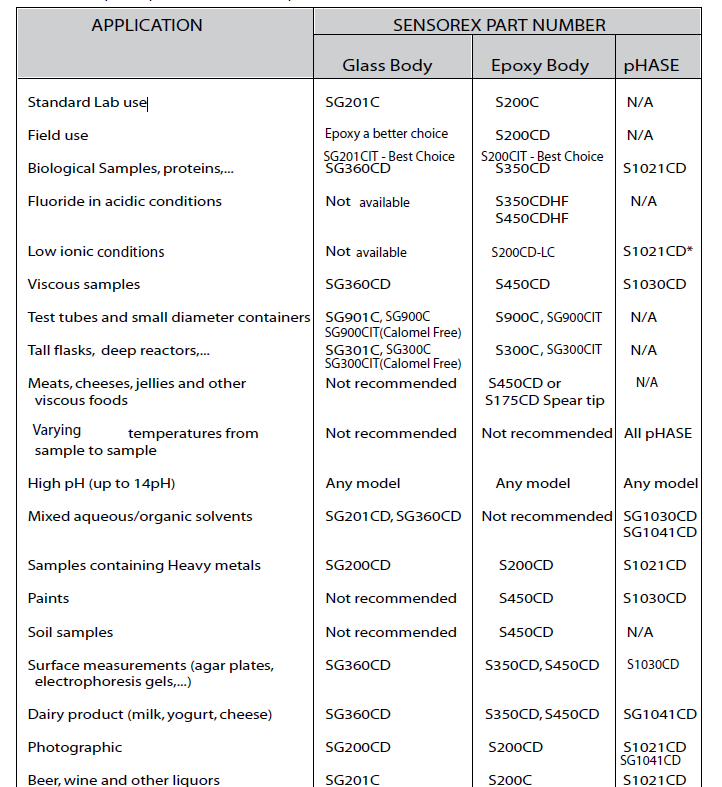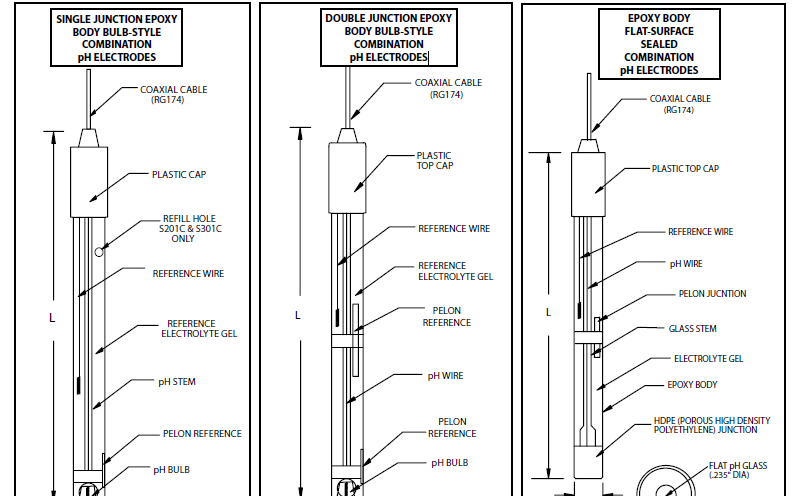
Water PH Sensor Plastic and Glass pH Electrodes
- Delivery Time:
- 3 Days
Quantity:
Your message must be between 20 to 2000 characters
Contact NowBasic Info
Basic Info
| Place of Origin: | United States |
|---|
Product Description
Product Description
PH Sensor for General Use Plastic and Glass pH and Reference Electrodes Model Number : SG200 Series 1.General Features Fast—95 % response in less than one second
(bulb-type only)
Combination or half cell designs
Single or double junction construction
Choose between sealed and re-fillable models
Choose between glass and plastic body models 2.Specifications
pH Range 0-14: (Na+ error at >12.3 pH)
Response :95% in 1 second (bulb-type only)
95% in 5 seconds (flat-type only)
Isopotential Point : pH 7.00 (0 mV)
Offset : +/- 0.20 pH
Span :97% of theoretical or higher 3.Combination or Separate Electrodes? Sensorex makes both separate and combination electrodes. The
convenience of handling one combination electrode as compared
to using separate pH and reference electrodes has been well
established in laboratory and portable pH measurements. The
price of Sensorex combination electrodes is much less than the
total price of the separate electrodes. Individual half cell electrodes
are used only for special purposes.
4.Glass or Plastic Body Electrodes?
Sensorex makes both body types and both provide the identical
excellent pH measurement. Traditionally, pH electrodes have been
made of all glass construction, but today’s plastics allow pH
electrodes to be constructed with sturdy and chemically resistant
epoxy or premium ULTEM bodies. The recessed protected design
of the Sensorex plastic body electrodes extends over the
measuring surface, ensuring that the pH glass bulb is virtually
unbreakable.
5.Single or Double Junction Reference?
Most pH measurements can be made with single junction reference
electrodes. However, materials such as heavy metals, proteins
and sulfides can precipitate at the junction. Double junction
designs use a buffering salt such as KNO3 in the lower chamber
contacting the sample, and preventing these reactions. They are
also useful for pH measurement of tris buffers. Both combination
or separate reference electrodes are available from Sensorex. 6.How do I choose the appropriate laboratory electrode for my use? OR: Select by electrode type you currently use:
a) Combination pH or ORP
b) Sealed or re-fillable reference
c) Epoxy or glass body
d) Dimension required Length and diameter (12mm dia x 150mm L is most common)
e) Separate pH or ORP half-cell/separate reference half -cell

 Lieen Skype:isweek_lieenli Sale Dep.Shenzhen Week Technology Ltd Tel: +86-755-83289036 Ext.817 Fax: +86-755-83289053 www.isweek.com
Lieen Skype:isweek_lieenli Sale Dep.Shenzhen Week Technology Ltd Tel: +86-755-83289036 Ext.817 Fax: +86-755-83289053 www.isweek.com
(bulb-type only)
Combination or half cell designs
Single or double junction construction
Choose between sealed and re-fillable models
Choose between glass and plastic body models 2.Specifications
pH Range 0-14: (Na+ error at >12.3 pH)
Response :95% in 1 second (bulb-type only)
95% in 5 seconds (flat-type only)
Isopotential Point : pH 7.00 (0 mV)
Offset : +/- 0.20 pH
Span :97% of theoretical or higher 3.Combination or Separate Electrodes? Sensorex makes both separate and combination electrodes. The
convenience of handling one combination electrode as compared
to using separate pH and reference electrodes has been well
established in laboratory and portable pH measurements. The
price of Sensorex combination electrodes is much less than the
total price of the separate electrodes. Individual half cell electrodes
are used only for special purposes.
4.Glass or Plastic Body Electrodes?
Sensorex makes both body types and both provide the identical
excellent pH measurement. Traditionally, pH electrodes have been
made of all glass construction, but today’s plastics allow pH
electrodes to be constructed with sturdy and chemically resistant
epoxy or premium ULTEM bodies. The recessed protected design
of the Sensorex plastic body electrodes extends over the
measuring surface, ensuring that the pH glass bulb is virtually
unbreakable.
5.Single or Double Junction Reference?
Most pH measurements can be made with single junction reference
electrodes. However, materials such as heavy metals, proteins
and sulfides can precipitate at the junction. Double junction
designs use a buffering salt such as KNO3 in the lower chamber
contacting the sample, and preventing these reactions. They are
also useful for pH measurement of tris buffers. Both combination
or separate reference electrodes are available from Sensorex. 6.How do I choose the appropriate laboratory electrode for my use? OR: Select by electrode type you currently use:
a) Combination pH or ORP
b) Sealed or re-fillable reference
c) Epoxy or glass body
d) Dimension required Length and diameter (12mm dia x 150mm L is most common)
e) Separate pH or ORP half-cell/separate reference half -cell


 Lieen Skype:isweek_lieenli Sale Dep.Shenzhen Week Technology Ltd Tel: +86-755-83289036 Ext.817 Fax: +86-755-83289053 www.isweek.com
Lieen Skype:isweek_lieenli Sale Dep.Shenzhen Week Technology Ltd Tel: +86-755-83289036 Ext.817 Fax: +86-755-83289053 www.isweek.com Related Keywords
Related Keywords
You May Also Like
You May Also Like








